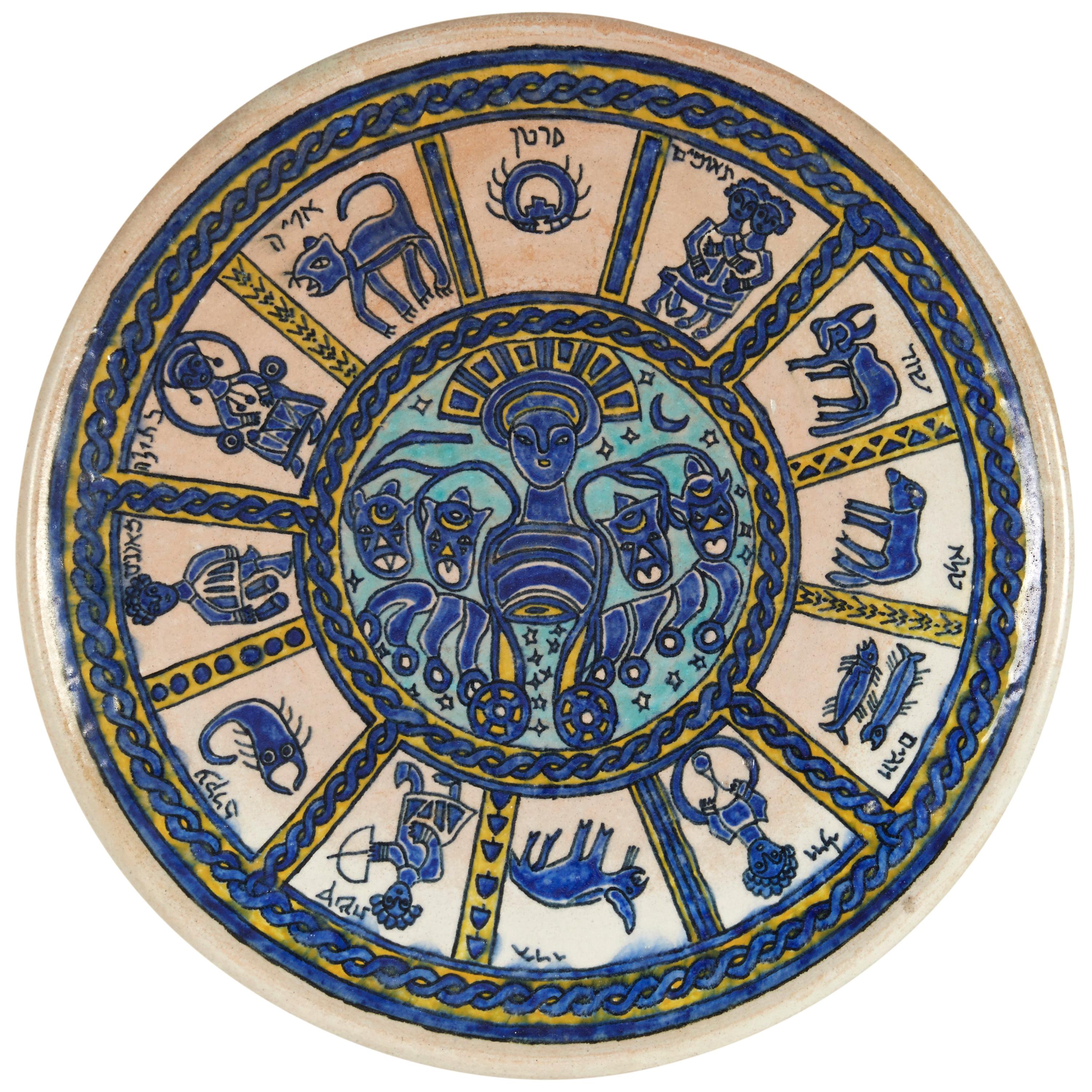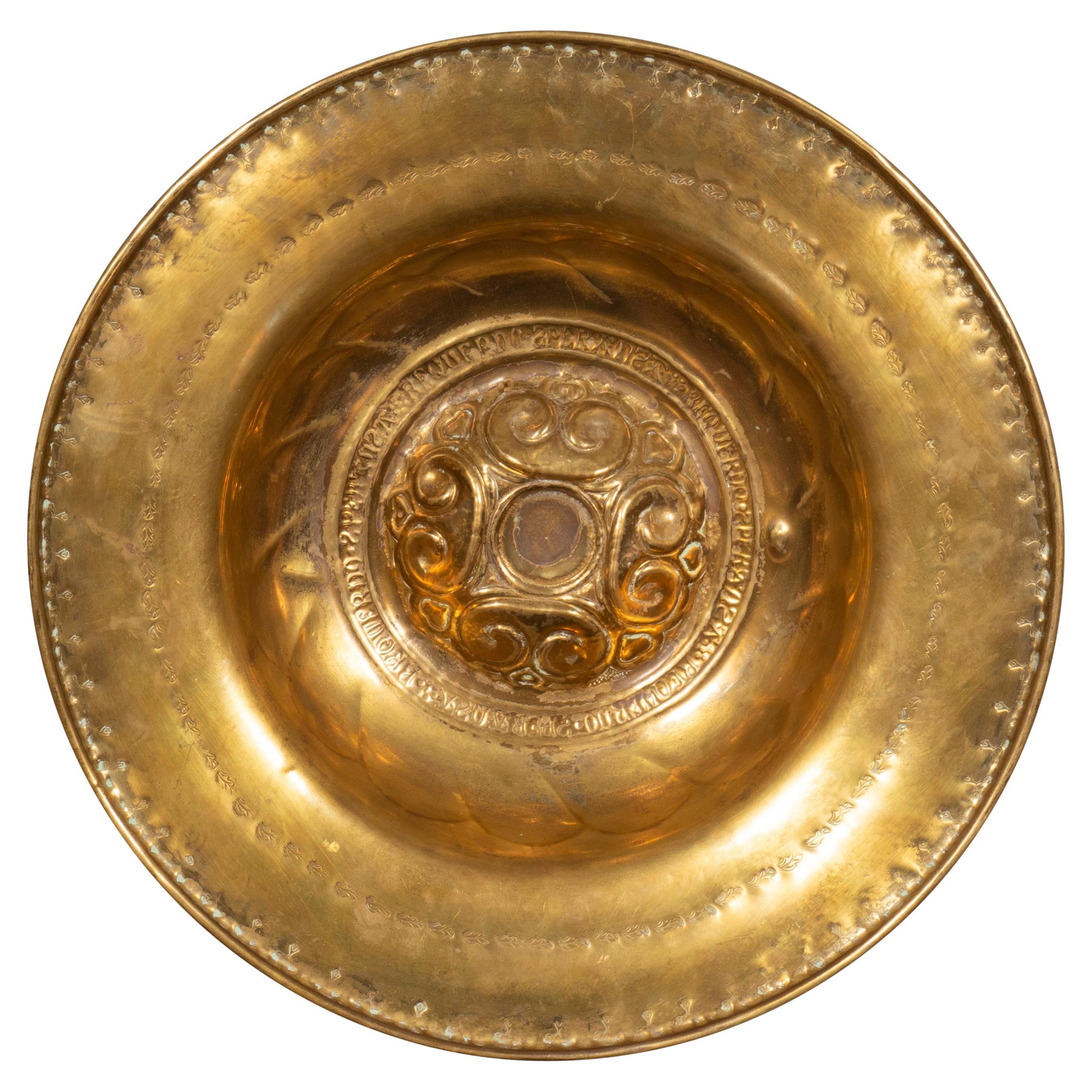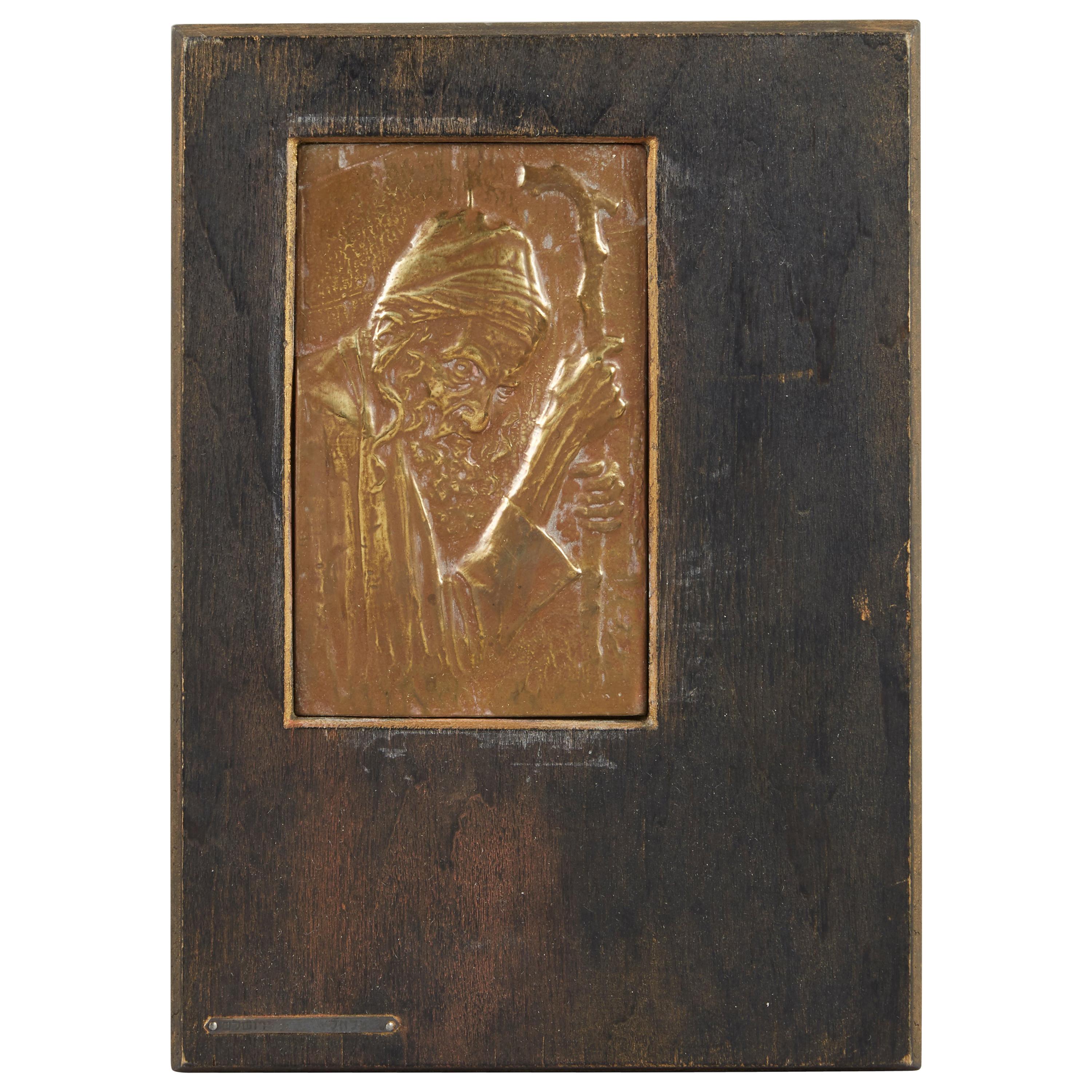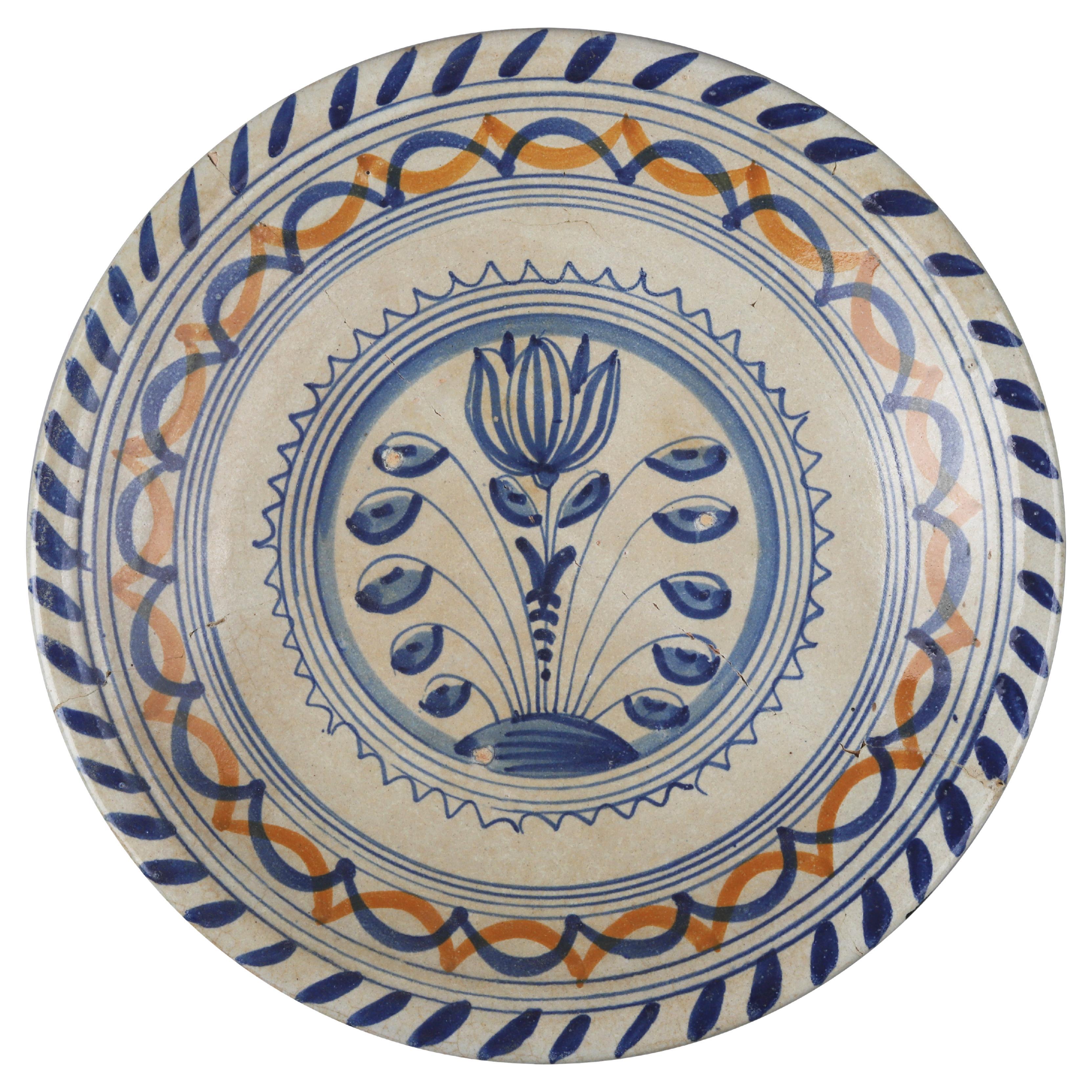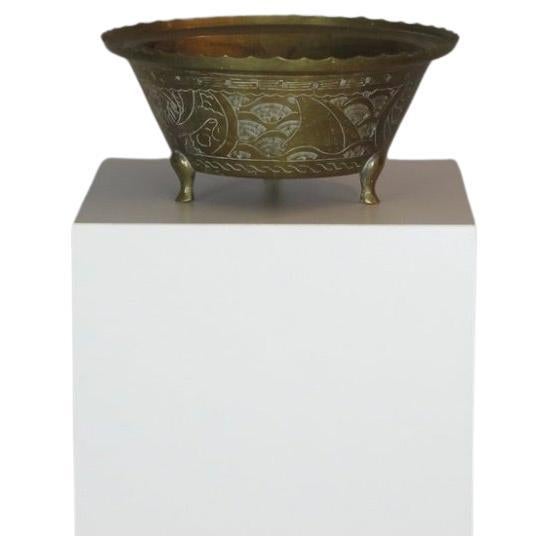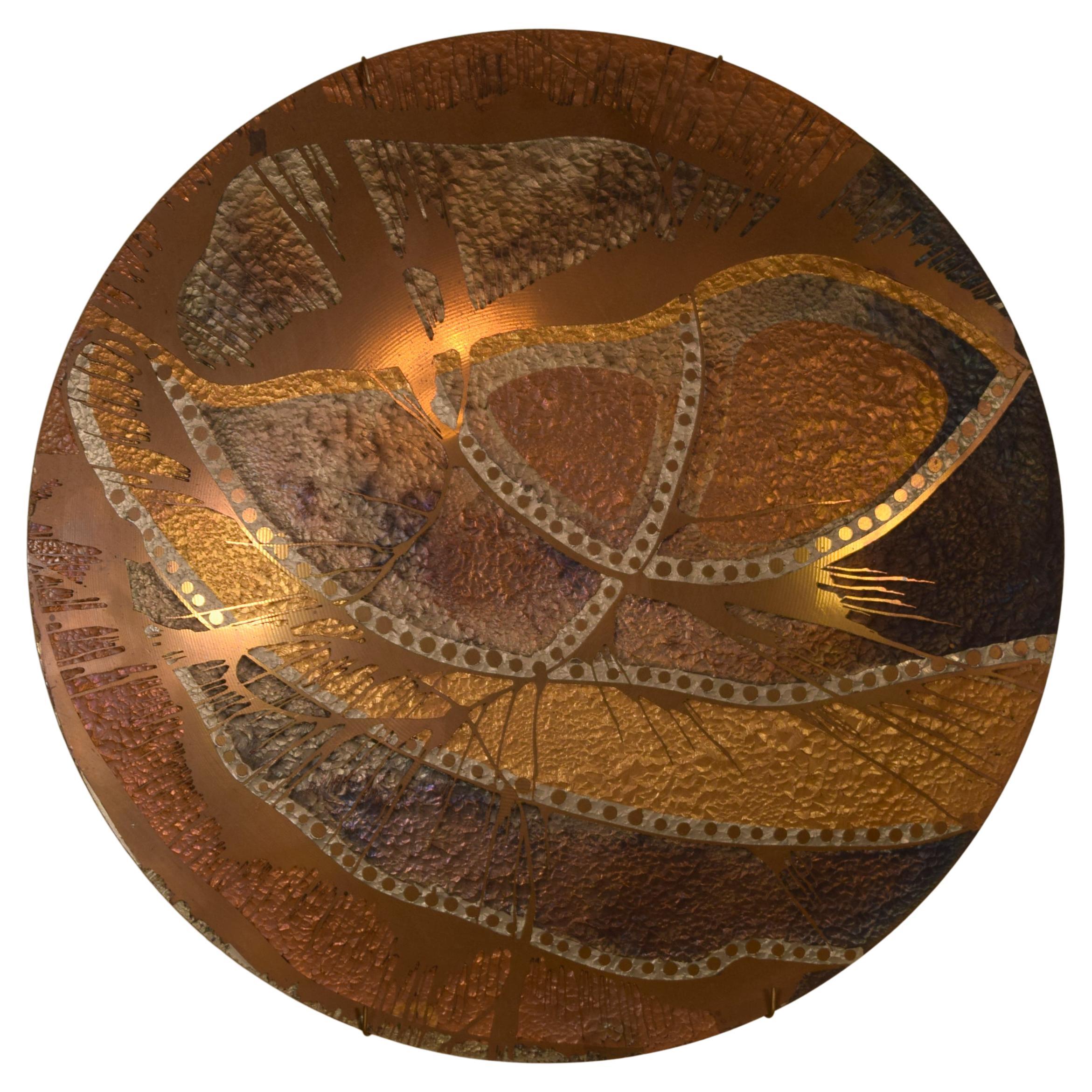Items Similar to Rare early Bezalel Jerusalem JUDAICA etched brass garden of eden plate
Want more images or videos?
Request additional images or videos from the seller
1 of 13
Rare early Bezalel Jerusalem JUDAICA etched brass garden of eden plate
About the Item
very rare Bezalel Jerusalem plate , this amazing plate has the best subject And artistic Design i have seen in a lot of years, the plate has 5 different scenes from the story Of Adam And Eve in the garden pf Eden.
On the middle of the plate the is an Hebrew inscription, it is parts from the 5 lines that describe The 5 scene on the plate:
"וַיִּ֩יצֶר֩ אֶת־הָֽאָדָ֗ם עָפָר֙ מִן־הָ֣אֲדָמָ֔ה"
"And the Lord God formed man of dust from the ground"
"לֹא־ט֛וֹב הֱי֥וֹת הָֽאָדָ֖ם לְבַדּ֑וֹ"
"And the Lord God said, "It is not good that man is alone"
"'וַיִּֽהְי֤וּ שְׁנֵיהֶם֙ עֲרוּמִּ֔ים"
"Now they were both naked"
"וַתִּקַּ֥ח מִפִּרְי֖וֹ וַתֹּאכַ֑ל וַתִּתֵּ֧ן גַּם־לְאִישָׁ֛הּ"
"She took of its fruit, and she ate, and she gave also to her husband"
"וַיְגָ֖רֶשׁ אֶת־הָֽאָדָ֑ם וַיַּשְׁכֵּן֩ מִקֶּ֨דֶם לְגַן־עֵ֜דֶן אֶת־הַכְּרֻבִ֗ים וְאֵ֨ת לַ֤הַט הַחֶ֨רֶב֙ הַמִּתְהַפֶּ֔כֶת לִשְׁמֹ֕ר אֶת־דֶּ֖רֶךְ עֵ֥ץ הַֽחַיִּֽים:"
"And He drove the man out, and He stationed from the east of the Garden of Eden the cherubim and the blade of the revolving sword, to guard the way to the Tree of Life."
This rare plate is fully marked on the back "BEZALEL JERUSALEM" in Hebrew, the Jerusalem Mark is a bit worn but it is present, on the top of the mark there is the number 522 which is Probably the model number, this plate was mad on the early 1910s or even earlier and it is one of Bezalel earliest works, it is not known who is the artist but the artistic style is typical of Reuben Leaf Lipschitz, he was working in Bezalel in 1912-1916 and was the manager of the etching Department in this time frame, in 1916 he moved to the USA to escape joining the ottoman army in ww1. he stayed in the USA and became a graphic designer who designed and decorated Synagogues he also made graphic designs a illustrations to Hebrew books.
Most have in any important Judaica or Bezalel collection
- Dimensions:Height: 1 in (2.54 cm)Diameter: 7.3 in (18.55 cm)
- Style:Arts and Crafts (Of the Period)
- Materials and Techniques:
- Place of Origin:
- Period:1910-1919
- Date of Manufacture:1913
- Condition:Wear consistent with age and use. Condition of the plate is very good, there are some scratches and some normal wear, the hanger On the back is missing as you can see in the pictures but otherwise good original condition to an Item is 100+ years.
- Seller Location:Tel Aviv - Jaffa, IL
- Reference Number:1stDibs: LU8130238132062
About the Seller
No Reviews Yet
Vetted Seller
These experienced sellers undergo a comprehensive evaluation by our team of in-house experts.
1stDibs seller since 2023
- ShippingRetrieving quote...Ships From: Tel Aviv - Jaffa, Israel
- Return PolicyThis item cannot be returned.
More From This SellerView All
- rare Silver picture frame, Bezalel School Jerusalem, Zeev Raban, Israel, JewishLocated in Tel Aviv - Jaffa, ILThis is an important and super rare picture frame, all hand made from silver, by the way the work was done and by the design it was hand made by Zeev Raban, in the last picture you c...Category
20th Century Israeli Jugendstil Picture Frames
MaterialsSilver
- Important Early 20th Century Silver Kiddush Goblet by Bezalel School JerusalemLocated in Tel Aviv - Jaffa, ILImportant Handmade sterling silver Kiddush goblet by Bezalel School, Jerusalem, circa 1910-1913. On round base decorated with silver filigree and Cabouchon shaped green agate applications. The base fitted with Bezalel mark. The upper portion is all adorned with amazing filigree work, the base and the actual cup adorned with swirling filigree designs, in the middle there are 3 roundels, made in another technique of hammered silver, similar to the works that were produced in this time all over Europe, in the middle of each roundel there is a perfectly centered Cabouchon green agate. This work is attributed to Yehia Yemini. The goblet is marked on the base, with the earliest silver mark of the school that just say "Bezalel" in Hebrew. Yehia Yemini : Was one of the biggest and must famous Bezalel silver...Category
Early 20th Century Israeli Jugendstil Sterling Silver
MaterialsSilver
- Important Early 20th Century Silver Kiddush cup by Bezalel School JerusalemLocated in Tel Aviv - Jaffa, ILImportant Handmade sterling silver Kiddush goblet by Bezalel School, Jerusalem, Circa 1910-1913. On the cup there are 3 identical scenes of flanked lions and on the middle of them There are two columns with a staircase, this design is probably taken from Eastern European torah ark, on the middle part there is a chandelier with 3 tiger/lioness Heads, the top of the cup has 3 inscription on top of each flanking lions scene, first One says : ״כוס ישועות אשא״ (Psalms 116:13) which means " I will take the cup of Salvation", this is a rather common blessing on kiddush cups. Next inscription says : ״אין שמחה אלא ביין״ in English " there is no joy except in wine" This says that after the temple was destroyed we have our joy only in the wine of Kiddish. The last inscription says ״ושמחת בחגך״ (Deuteronomy 16:14 ) in English : "And you shall rejoice in your festival". So this cup is a kiddish cup...Category
Vintage 1910s Israeli Art Nouveau Sterling Silver
MaterialsSilver
- Early 20th Century Silver Spice Tower by Yehia Yemini, Bezalel School JerusalemLocated in Tel Aviv - Jaffa, ILVery rare Bezalel Jerusalem silver filigree spice tower, this amazing spice Tower was Made by Yehia Yemini, who was the best filigree artist in bezal...Category
Vintage 1920s Israeli Sterling Silver
MaterialsSilver
- extremely rare Algerian Judaica silver, jewish Dowry box early 19th centuryLocated in Tel Aviv - Jaffa, ILAmazing and scarce JUDAICA object, we have here one of the most touching jewish objects we had for a long time, this small silver dowry box was made in Algeria in the early 19th century, it is all covered with symbols of jewish faith and of couples, the sliding lid has 2 flanking birds with hamsa (protective hand) on each side and a flower vase in the middle. one side shows two flanking lions with a tree in the middle and the other side shows again two big and two small birds with a flower bowl in the middle, front side has a key hole and next to it there is the Hebrew inscription ס״ט״" which says Siman tov or in English "a good sign" it is taken from the wedding blessing, underneath the lock there is another inscription with the name ״עזיזה בת אברהם בן חמו״ which is the name of the bride, her father and her grandfathers name. the box is full marked a lot of times with the silversmith mark, every side of the box is marked. this box was probably ordered by the grooms family to hold the jewelry they are giving to the bride as dowry, this type of objects are rare and there are just a few of them on museum collections. DOWRY (Heb. נְדֻנְיָה), the property a wife brings to her husband at marriage; the Yiddish equivalent, nadn, is from the same root. The custom of nedunyah became clearly defined and institutionalized only in the talmudic period. In biblical times, mohar (מֹהַר), whereby the groom bought his wife from her father (Gen. 24:53; Ex. 22:15–16; Hos. 3:2), was the accepted practice. It was then customary that the groom give the bride gifts, and that she bring certain property to her husband's home upon marriage: slaves, cattle, real estate, etc. (cf. Gen. 24:59–61; 29; Judg. 1:14ff.; I Kings 9:16). Evidence of the custom of nedunyah is to be found in Tobit (7:14; 8:21) and in the Assuan papyri (Cowley, Aramaic, nos. 15, 18). Gradually, mohar was superseded by the ketubbah custom according to which the husband merely assumed the responsibility of compensation to his wife in case he divorced her: he had to pay her 200 zuzim if she had been a virgin at the time of marriage, and 100 zuzim if a widow or divorcée (see *Ketubbah). By talmudic times, the institution of nedunyah was prevalent; the father gave a dowry to the bride since the daughter was excluded from paternal inheritance. Fifty zuzim (equivalent to the worth of 180 grams of silver) was the minimum amount a father was obliged to give to his daughter (Ket. 6:5). Parents usually gave much more, according to their social standing. Community funds provided the dowry for an orphan or a very poor girl (ibid.; cf. Sh. Ar., YD 251:8). In case of her father's death, the brothers of a minor girl were obliged to give her the minimum dowry, and the court estimated how much her father would have given her above the minimum dowry. The sum was then taken out of the father's estate and given to the daughter upon majority (Ket. 6:6; 68a–69b). In the absence of such an estimate, each daughter was entitled to receive one-tenth of the value of her father's estate in money, or in valuables (Yad, Ishut, 20:4–7; Sh. Ar., EH 113:4). If the father was unable or unwilling to pay the promised dowry at the betrothal ceremony, the groom could refuse to marry his bride (Ket. 13:5; Ket. 108b–109a). Insistence on exact payment of the promised dowry, however, was frowned upon by later rabbinic authorities (Rema to Sh. Ar., EH 2:1). In certain communities it was customary for the groom's father to make a dowry contribution equal to that of the bride's father (Ket. 102b). The dowry, whether given in real estate, slaves, money, or chattel was recorded in the marriage contract (the ketubbah) and in some instances one-third or one-fifth of the actual value of the dowry was added to the sum mentioned in the ketubbah. Based upon a decree enacted by *Simeon b. Shetah (first century C.E.), the Talmud ruled that the husband and his entire property were liable for compensation as stipulated in the ketubbah, either in case he died (when she collected the sum specified in the ketubbah from the heirs) or in case he divorced his wife (Ket. 82b). For the status of the dowry and the husband's rights and obligations, see below. The rabbinic enactments (Takkanot Shum) by R. Jacob *Tam and by the rabbinic synod of the communities of Speyer, Worms, and Mainz (Germany) stipulated that if a woman died...Category
Antique Mid-19th Century Algerian Tribal Art
MaterialsSilver
- French faience Passover plate, JUDAICA 19th centuryLocated in Tel Aviv - Jaffa, ILthis plate has a creme white background, the center painted with a man holding a lamb before a cityscape, probably a depiction of Jerusalem by someone who never actually visited the city or even see it, under the man there is the word Passover "פסח" the rim with the order of the Seder, and some grape vines between them. Passover, also called Pesach ( Biblical Hebrew: חַג הַפֶּסַח, romanized: Ḥag haPesaḥ), is a major Jewish holiday, one of the three pilgrimage festivals, that celebrates the Biblical story of the Israelites' escape from slavery in Egypt. Pesach starts on the 15th day of the Hebrew month of Nisan which is considered the first month of the Hebrew year. The Hebrew calendar...Category
Antique Late 19th Century French Victorian Platters and Serveware
MaterialsPottery
You May Also Like
- Early 20th Century Armenian Pottery Plate from JerusalemLocated in New York, NYExtremely rare Armenian pottery plate depicting the mosaic floor at the ancient synagogue of Beit Alpha in Israel, circa 1920. Jerusalem's ancient Arm...Category
Vintage 1920s Israeli Decorative Art
MaterialsPottery
- Early European Brass Alms PlateLocated in Essex, MAWith deeply molded body with central inner scrolled design. The outer with stamped decoration.Category
Antique 1680s European Baroque Decorative Bowls
MaterialsBrass
- Early 20th Century Brass Plaque by Bezalel School JerusalemLocated in New York, NYBezalel brass plaque depicting a Jewish elder next to the Western Wall, made in Jerusalem, circa 1920, bearing a small metal label engraved "Bezalel Jeru...Category
Early 20th Century Israeli Decorative Art
MaterialsBrass
- Rare Dutch Majolica Plate with Tulip, Early 17th CenturyLocated in AMSTERDAM, NHA rare Dutch Majolica plate with a decoration of a tulip. Northern Netherlands, probably made in the city of Rotterdam. Made 1620 - 1640 Dutch majo...Category
Antique Early 17th Century Dutch Renaissance Ceramics
MaterialsCeramic, Majolica
- Large Antique Etched Brass BowlLocated in Pittsburgh, PALarge Antique Etched Brass Bowl with dragon Detail. China, circa early 20th century.Category
Early 20th Century Chinese Chinese Export Decorative Bowls
MaterialsBrass
- Lee Barnes Peck Abstract Bronze Etched PlateBy Lee Barnes PeckLocated in South Charleston, WVMeasures: 12.5" x 1.75. Produced circa 1975 by Lee Barnes Peck. Modernist large decorative plate with original shop tag detailing the production of the plate using bronze, and a mult...Category
Mid-20th Century American Mid-Century Modern Decorative Bowls
MaterialsBronze
Recently Viewed
View AllMore Ways To Browse
Engraved Brass Plates Engraved Brass Plates
Zsolnay Plate
Monique Gerber Bronze
Square Vide Poches
Art Deco Vide Poches
Mid Modern Vide Poches Glazed
Danish Oak Bedside
Double Sconce Set Of Four
Ironstone Pink
Pair Of Rope Mirrors
Stairwell Lamp
Tables By American Of Martinsville
Louis Parlor Set
Smoked Glass Black Frame Coffee Table
Test Tube Lamps
Woodard Aluminum Furniture
Cesare Lacca Tea Trolley
French Gas Lamp
